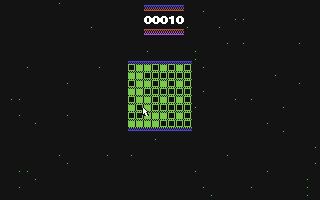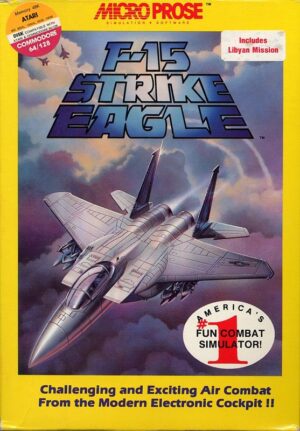Retro Replay Review
Gameplay
Block Fill delivers a straightforward yet captivating puzzle experience built around a classic 8×8 grid. Each square on the grid can be either solid or empty, and your mission is to turn every tile solid by cleverly inverting 2×2 blocks. The controls are crisp and responsive—you simply move a cursor with the joystick and hit the “Fire” button to flip the four squares beneath it. The tactile satisfaction of each toggle quickly becomes addictive, encouraging you to experiment with different move sequences.
(HEY YOU!! We hope you enjoy! We try not to run ads. So basically, this is a very expensive hobby running this site. Please consider joining us for updates, forums, and more. Network w/ us to make some cash or friends while retro gaming, and you can win some free retro games for posting. Okay, carry on 👍)
What sets Block Fill apart is its nod to the renowned “Lights Out” formula, reinvented through a 2×2 inversion mechanic. With 16 distinct starting configurations, the game strikes a balance between accessibility and challenge. Early levels serve as warm-ups, allowing you to understand how flipping one block affects its neighbors. As you progress, patterns become more intricate, forcing you to plan multiple steps ahead. This layering of complexity keeps the gameplay loop engaging well beyond the first few puzzles.
Despite its minimal premise, the depth of Block Fill shines through its elegant rule set. There’s no timer pressure or move limit, which means you can take your time devising the optimal solution. However, for puzzle purists who crave a competitive edge, the unofficial challenge arises from beating your own best move counts. For those new to logic puzzles, the intuitive feedback system—highlighting which tiles change—helps demystify the chain reactions that can at first feel overwhelming.
Graphics
Visually, Block Fill adopts a clean, retro-inspired palette that focuses on clarity over flair. Solid squares are rendered in a bold color, while empty squares are left unfilled or lightly shaded, creating a high-contrast grid that’s easy on the eyes. The simplicity of the visuals ensures that the core puzzle mechanics remain front and center, without any distracting flourishes or unnecessary details.
Animations are minimal yet effective: each time you press “Fire,” the four affected tiles flip with a satisfying snap. This instantaneous feedback helps you track the direct impact of your actions and reinforces the cause-and-effect relationship crucial to puzzle-solving. While there’s no dynamic background or flashy particle effects, the subtle sound cues paired with the grid animations make each move feel meaningful.
Since Block Fill originated as an entry in the MiniGame Compo 2008, its graphic style intentionally embraces pared-down aesthetics suitable for rapid development. Yet this limitation works in its favor—there’s a charming nostalgia to the no-frills presentation that recalls early handheld puzzle titles. If you value function over form, you’ll appreciate how the clean interface keeps your focus solely on the logic at hand.
Story
Block Fill doesn’t boast a narrative in the traditional sense—it is, first and foremost, a pure puzzler designed to test your spatial reasoning. There’s no cast of characters or plot twists, and that’s precisely the point. The game’s minimalist approach strips away narrative distractions so you can immerse yourself fully in the logic challenges.
That said, the context of its creation lends it an underdog charm. As a participant in the MiniGame Compo 2008, Block Fill stands as a testament to rapid indie development and creative problem-solving under time constraints. Knowing this backstory adds an element of appreciation for how much strategic depth the developer achieved in a limited timeframe.
For some players, the lack of a storyline could feel like a blank canvas—an invitation to project their own motivations onto each puzzle. Are you repairing a virtual machine, filling in a futuristic data matrix, or simply indulging a love for geometric logic? Block Fill leaves these interpretations up to you, ensuring that the narrative remains as flexible as its gameplay grid.
Overall Experience
Block Fill excels as a bite-sized brainteaser designed for quick sessions and extended play alike. Whether you have five minutes to spare or are looking to tackle all 16 setups in one sitting, the game adapts to your schedule. Its pick-up-and-play nature makes it ideal for commuting, coffee breaks, or winding down before bed—whenever you crave a mental workout.
Replayability stems not only from the 16 initial puzzles but also from the personal challenge of refining your solutions. Enthusiasts of minimalist design will appreciate how every element serves the core mechanic, while puzzle veterans will find satisfaction in mastering each grid configuration. Although there’s no online leaderboard or timed mode, the intrinsic motivation to optimize your flip count ensures ongoing engagement.
In sum, Block Fill may wear its simplicity on its sleeve, but it delivers a puzzle experience that’s both accessible and intellectually stimulating. Its retro charm, intuitive mechanics, and steady difficulty curve make it a noteworthy entry among indie logic games. If you’re seeking a no-nonsense, brain-bending diversion, Block Fill is worth exploring—and it stands as a shining example of how a small concept can yield a big impact.
 Retro Replay Retro Replay gaming reviews, news, emulation, geek stuff and more!
Retro Replay Retro Replay gaming reviews, news, emulation, geek stuff and more!




Reviews
There are no reviews yet.